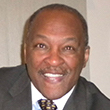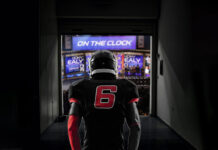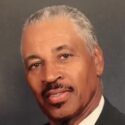
 Dr. Al-Tony Gilmore, a Distinguished Historian Emeritus of the National Education Association, has researched, lectured, and published widely on the intersection of sports and society, including his seminal book, Bad Nigger: The National Impact of Jack Johnson (Associated Faculty Press, 1975). He has been a history professor at Howard University, the University of Maryland, and a Visiting Scholar at George Washington University.
Dr. Al-Tony Gilmore, a Distinguished Historian Emeritus of the National Education Association, has researched, lectured, and published widely on the intersection of sports and society, including his seminal book, Bad Nigger: The National Impact of Jack Johnson (Associated Faculty Press, 1975). He has been a history professor at Howard University, the University of Maryland, and a Visiting Scholar at George Washington University.Here Dr. Gilmore examines the history of Black football players from HBCUs in the National Football League.
While it is something of a disappointment that not a single HBCU football player was drafted by the National Football League in 2021, it is not much of a surprise. Only one player from a HBCU was drafted in 2020, and none in nine separate drafts since 2000.
Thus, it is somewhat disingenuous to blame the results of the NFL 2021 draft on the cancellations of 99 percent of the Fall 2020 HBCU football games because of the pandemic, or to any other reason that evades an admission that the quality of HBCU athletes consistently falls short of NFL standards. But, it is important and instructive to remember and reflect that it was not always this way.
In 1952 Jack Spinks of Alcorn State University in Mississippi created excitement among Black sports fans when he became the first HBCU football player to be drafted by the NFL, though undrafted Tank Younger of the Los Angeles Rams, who played at Grambling University in Louisiana, had become a prominent player a few years earlier.
For the remainder of the decade a small number of HBCU players were also drafted including Willie Galimore (Florida A&M Univerity) and Charlie Bivins (Morris Brown College) the Chicago Bears; Johnny Sample and Roger Brown (Maryland State ) Baltimore Colts and Detroit Lions; Roosevelt Brown (Morgan State University) New York Giants; Willie Davis (Grambling State University) Cleveland Browns; Jack McLaren (Bethune-Cookman University) Pittsburgh Steelers; Deacon Jones (Mississippi Valley State University) Los Angeles Rams; Leo Miles (Virginia State University) New York Giants; John Baker and Chuck Hinton ( North Carolina Central University) Rams and Steelers; and Charlie Brackins and Elijah Pitts (Prairie View A&M University and Philander Smith College) Green Bay Packers. Between 1946 and 1962, 173 Black players had played in the NFL but only 42 of those came from HBCUs, and up until 1960 no player from a HBCU was selected higher than the 4th round.
Just as Jackie Robinson’s integration of major league baseball and Brown v. Board of Education ushered in an era of moderate integration, the increased agitation of the Civil Rights Movement and Martin Luther King, Jr. promoted a racial climate that improved the draft prospects of HBCU players, at a time when a large share of HBCU players met NFL standards, and when NFL owners better equated HBCU players with winning and revenues.
When the rival American Football League (AFL) was formed in 1960, the best players at HBCUs benefited for two reasons: both leagues drafted from the same pool of players, and the upstart league ignored the etiquette of team quotas for Black players. Its primary goal was to put the best product on the playing field.
In 1960, 75 percent of the NFL’s first-round draft picks signed with the AFL, and its teams stocked themselves with under-publicized but outstanding HBCU players, most of whom were drafted by both leagues, which gave them options in negotiating for the best contracts and improving chances of making the rosters. In 1963, Buck Buchanan of Grambling State University was the overall No. 1 pick of the AFL’s Kansas City Chiefs, becoming the first Black player from any college to achieve that honor. By contrast, with the more racially conservative NFL, Buchanan was the 265th player selected overall by the New York Giants in the 17th round.
By 1967 the AFL and NFL floodgates had opened so wide that the Super Bowl roster of the Kansas City Chiefs had 13 HBCU players. In the 1969 Super Bowl when the AFL’s New York Jets upset the Baltimore Colts, the Jets’ roster had eight players from HBCUs while the Colts had six.
When the two leagues merged in 1970, no one could deny the role of HBCU players in making that historic event happen. Ironically, in that same year, the implications of what occurred in a single game triggered a reversal in the overall quality of HBCU football recruits and subsequently led to a downward trend in HBCU selections in the draft.
The University of Alabama and the University of Southern California met in the marquee football matchup of that year at Legion Field in Birmingham. The all-White Alabama team made a last stand for segregated college football teams but was crushed 42-21 by the USC team led by an unprecedented all-Black backfield.
The handwriting on the wall had never been more transparent, college football teams with winning aspirations had to recruit Black players. Four years earlier in 1966, the same had happened in college basketball when an all-Black starting lineup at Texas Western College (now the Univerity of Texas at El Paso) soundly defeated an all-White Kentucky team, then the most dominant college basketball program for over a generation.
In the aftermath of those two games, once segregated college football teams, as well as those that had long-established patterns of recruiting limited quotas of Black players, actively recruited Black players in increasing numbers, raiding what once had been the domain of HBCUs. This was the beginning of the decline in the quality of players recruited by HBCUs, which simply did not have the resources and media exposure to compete with the larger predominately White schools for the best Black athletes.
But the HBCUs’ well did not run dry overnight. They continued to produce Hall of Fame and high-quality players who were drafted by the NFL but in increasingly smaller numbers. In 1974, Ed “Too Tall” Jones of Tennesse State became the first player from an HBCU to be selected as the No. 1 pick in the NFL draft. Since that time notable NFL draftees from HBCUs include Walter Payton, Jerry Rice, Steve McNair, Doug Williams, Harry Carson, Michael Strahorn, Shannon Sharpe, and others, some of whom were not drafted but signed and made NFL rosters as free agents.
In 2021 the NFL conducted an HBCU combine for players deserving closer examination by NFL scouts. Unfortunately due to the pandemic those players were in the difficult position of not playing competitively in over a year, with the exception of some Southwestern Athletic Conference schools (SWAC) which competed in a truncated spring football schedule. This may explain why none of the five HBCU players, listed among the 460 by the NFL Draft Prospect Trackers, were selected in the draft.
Black NFL coaches and scouts – many HBCU alumni – are among those whose opinions contribute to draft selections. The goal, again, is to put the best product on the playing field. School pedigree does not necessarily carry weight in the draft process, though the level of college competition works against HBCUs and lower conference schools. Tennesse State University, Hampton University, and North Carolina A&T State University have broken long-established tradition and left historically Black athletic conferences for larger and more competitive conferences in efforts to improve the quality of their programs, which will enhance their ability to recruit more players who may prove to be of NFL quality.
Enthusiasm and excitement have been generated among followers of HBCU football over the recent hirings of high-profile coaches Deion Sanders at Jackson State and Eddie George at Tennessee State, two programs with storied traditions and a host of celebrated NFL alumni. It is hoped that the football acumen and name recognition of Sanders and George will improve the recruiting of better athletes while bringing wider media exposure to their teams and increasing revenue for their programs. Both have solid reputations, strong NFL relationships, and intricate knowledge of the requirements and developmental processes for making a NFL roster. Neither, however, has had collegiate head coaching experience, and both will be judged more by their ability to produce winning football teams than by producing NFL draftees.
Sanders and George are not the first former NFL players to become coaches at HBCUs, and will have to do much better than Super Bowl-winning quarterback Doug Williams, whose recent brief stint as head coach of Grambling University’s inadequately resourced program fell short of expectations. However, as a Washington Football Team senior advisor and trustee of the Black College Football Hall of Fame, Williams has admirably leveraged his considerable influence in helping secure the NFL’s support for a collegiate all-star game for HBCUs, which will debut in February 2022 in New Orleans. This showcasing of the best HBCU players, along with the NFL’s HBCU combine, may result in better draft dividends, though it may be mitigated by other developments.
The NCAA transfer portal is a lurking threat to HBCU football and may serve to siphon the best players to schools with more athletic resources and larger football profiles. Introduced in 2018, the portal is designed as a safety net for student-athletes who are displeased with coaching changes, coach relationships, playing opportunity, stockpiles at their position, or systems and schemes deemed incompatible with their styles of play. But for HBCU players, the portal takes on new meaning, especially for those who blossom and emerge as NFL draft prospects. To cite one recent example, two of Grambling’s premier linemen –one an all-conference selection — have decided to place their names in the portal. If this emerges as a pattern, HBCUs could soon become farm teams for larger football conferences, further diminishing the number of potential NFL draftees.
All things considered, the best explanation for the absence of HBCU players in the 2021 draft, is that it mirrors the bitter truth about the price that HBCUs have been forced to pay because of the integration of NCAA collegiate sports. No doubt, there will be other HBCU players who will be drafted or signed as free agents and make NFL rosters in future years, but they will be fugitives against the law of averages.
The odds are unfavorable that the past will repeat itself. The history of HBCUs in the drafts of the 1950s and 1960s is a unique snapshot in time, and it reflects the dynamics of segregation and early integration which no longer exist, one which drained an athletic talent pool where HBCUs once had a monopoly. Currently, nearly 10 percent of Black players in the NFL Hall of Fame are alumni of HBCUs. That percentage, too, will inevitably decline, but that history, too, cannot be erased. HBCUs were in the vortex of the racial transformation of the NFL.











Pure Excellence
Although one cannot dispute the facts of Dr. Gilmore’s excellent historical aritcle, there is a major positive that has emerged from the increase in top Black athletes going to universities in the Power 5. Now, more black male and female athletes will receive athletic scholarships at HBCU’s who would otherwise not have been recruited 4 decades ago. That means more, not fewer, Black students having access to the college experience and a college degree.
Excellent, positive observation.
Tony, well said. There is so much “HBCU” history.
We should be more concerned about HBCUs’ future, not history.
The past, present, and future of HBCUs must
all coexist for there to be any meaningful whole.
“Those who forget the past are doomed to repeat it”
is as applicable today as it was when Harvard philosopher
George Santayana wrote that sentiment in 1896.
JD Smith was drafted in round 15 in 1955. Attended Sterling High in Greenvill SC and NC A&T
Awesome and Indept, my brother from Bee st ,thanks for the great info, on such a timely subject